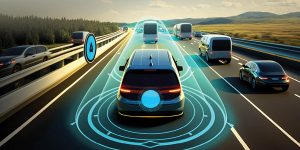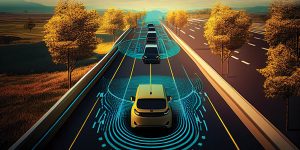In order to make future cities resilient and sustainable, integration of technological innovation with existing infrastructures is crucial for accommodating teeming population and catering to their needs and aspirations.
Major factors that are expected to drive the growth of the resilient cities are smart mobility, fast connectivity, ubiquitous location intelligence, government initiatives, and the rise of advanced technology solutions such as 5G and IoT.
Transportation plays a significant role in a city’s transformation, which is why many urban clusters form around the world have already evaluated and implemented smart solutions to their transportation system, while some are still trying to understand the concept.
For example, New York City has been investing in connected infrastructure and adaptive signals, installing cameras and sensors at over 10,000 city intersections. At the same time, Paris is preparing to become a green city – it is planning to replace its entire bus fleet by EVs. A lot of cities in Europe are developing separate lanes and parking spaces for micromobility vehicles.
City planners are becoming increasingly aware of this phenomenon and are trying to mould the city infrastructure to cater to the growing pressure of mobility needs.
“It would be impractical to expect all legacy infrastructural issues to be resolved by creating all-new solutions. The best approach is to look at solutions that are future-ready and can co-exist with reasonable upgrades of existing infrastructure. One such solution is micro-mobility,” says Amit Gupta, Co-Founder and CEO, Yulu.
ALSO READ: Top Five Mobility Trends to See in 2023
Intelligent Transportation Systems
According to the US Department of Transportation, “Intelligent Transportation Systems (ITS) apply a variety of technologies to monitor, evaluate, and manage transportation systems to enhance efficiency and safety.”
For efficiency, cities of the future would require IoT sensors for monitoring and managing traffic in real-time, and focusing on developing better connected vehicles, which is a costly affair but that’s where the future lies. Another important field that needs to be addressed is introducing smart vehicles like autonomous vehicles, electric vehicles, micromobility solutions.
“Cities can be better designed for being adaptive to micromobility by making short-mile and intra-city commute part of urban planning, having dedicated cycle lanes, ecosystem & adoption enabling policies and administrative support for new-age mobility solutions like Shared Mobility and clean mobility, etc.,” says Gupta.
Location Intelligence for Future Cities
Location intelligence reveals critical community relationships by bringing business, services, demographics information, and other details together with spatial data.
Location is the most effective tool to design, analyze, and visualize the next-generation digital city. Location insights can be used to more effectively plan efficient roadways that better accommodate current traffic patterns, the types of vehicles on the road, while anticipating future growth,” says Clarence Hempfield, Senior Vice President of Product Management at Precisely
Location intelligence and data provide ideal tools for cities to utilize their operational data, sensors, geo-referenced video, and more. Cities can use these insights to better plan infrastructure and public transportation that reduces emissions by analyzing busy locations including the time and day of peak travel, congestion patterns, and more.
“The same analysis can be used to implement new charging stations in high traffic areas and help better plan for walkable, mixed-use communities that reduce the reliance on motor vehicles,” adds Hempfield.
The powerful combination of location intelligence and data that is relevant, accurate, and fit-for-use unlocks critical context so that planners and city authorities can more efficiently and cost-effectively design, analyze, and visualize their development projects to meet the needs of their community today and into the future. Trusted data highlights critical characteristics about a community, such as demographic, socioeconomic, housing, and business variables.
“’The data integrity strategy, including location intelligence and data, will unlock a comprehensive view and assist the planning team in generating policies that support civic inclusion and sustainability”.
ALSO READ: Micromobility for Future Smart Cities
Need for Better Connected Cities
Adoption of micromobilities provide the overcrowded cities some breathable space. They are shareable, accessible and run on electricity/ chargeable battery, which is win-win for both the mobility company as well as for the consumer, who just want it for the first or last mile.
To improve the overall efficiency of a city, Information and communication technology (ICT) is the only tool that can provide that, which is why cities across the globe are extensively using ICT to provide updated information about improved facilities, governance, policy changes and to address the grievances as well as solve them in real-time, for their citizens.
“We need smart digital infrastructure like an open architecture, where people can plug in, but also provide the infrastructure, so that the government, police force, can protect it from being misused, at the same time,” says Sergio Fernandez de Cordova, the Executive Chairman of PVBLIC Foundation.
“Solutions are needed to be created at the micro level, because at the macro level, it’s just about providing the infrastructures, and at the micro level, it allows us to actually have these solutions benefit us.”
“When you’re looking at transportation, geospatial connectivity is the key so is access to connectivity,” adds Cordova.
Micro-mobility as Solution?
Urbanization is a mega trend that has picked up in the last few decades and is likely to continue for the foreseeable future. Cities have become the hubs for economic growth and result in a huge influx of people from rural & semi-urban areas to urban centres in pursuit of a better livelihood.
As most cities prioritise high-speed & comfortable mass public transit systems, like Metros & AC buses, technology-driven shared micromobility options can not only make them seamless but also more usable alternatives. Hence, technological solutions are the need of the hour for optimized and efficient use of resources in urban areas.
“Micromobility and multi-modal connectivity like Shared e-mobility go hand-in-hand with urban growth and smart cities, as they solve most of the daily commute needs of individuals and mitigates the stress on urban resources. Shared e-mobility also reduces the pollution level in cities and has the added benefit of being a vital connectivity link for public transport systems and metros which is the commute lifeline for a large portion of the populace in these cities,” adds Gupta.
ALSO READ: 1Spatial Introduces Traffic Management Solution in UK









